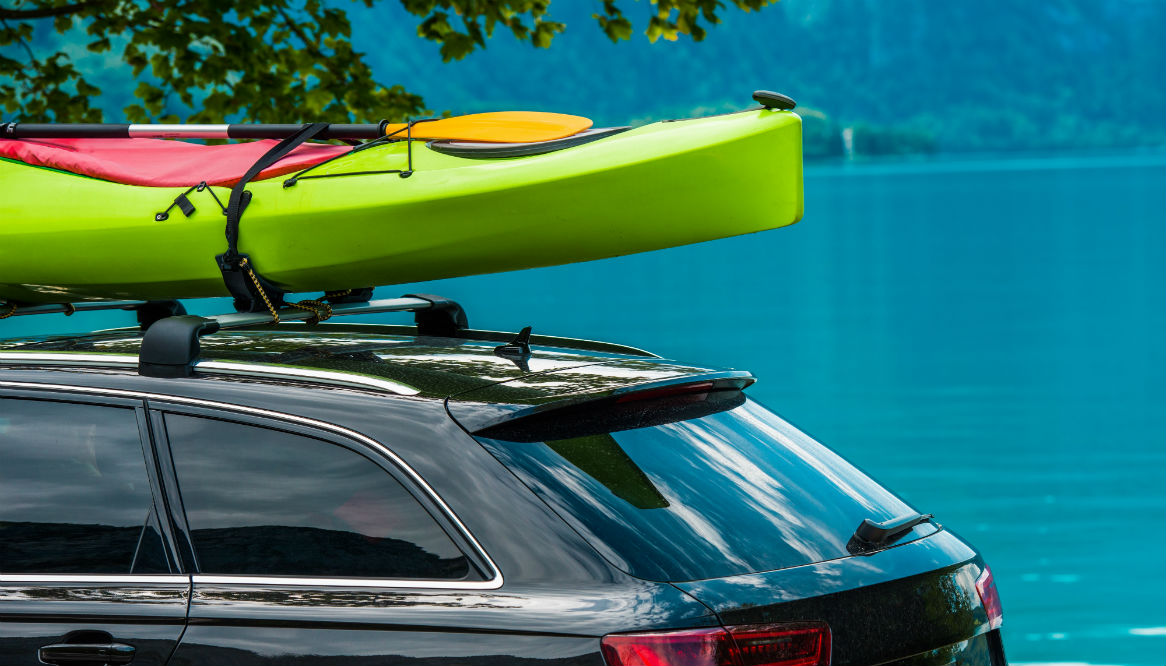
Kayaking is a fun sport for young and old, but one of the biggest issues many kayakers face is loading the boat onto their vehicle, and then offloading it into the water. How to transport a kayak is one of the most important questions to answer before investing in the boat and maybe even your vehicle. Most kayakers transport their kayak by attaching it to the top of their vehicle with the help of rooftop racks or other similar accessories.
While you can transport your kayak on just about any vehicle, some kayak transportation systems work better than others. Foam blocks are an inexpensive way to transport a kayak compared to rooftop racks, and are an ideal choice for short trips in good weather.
Contrarily, rooftop racks are a more secure way to haul your kayak around on longer trips and highways where speed limits and wind speeds are typically higher. Furthermore, kayak roof racks in most cases can also be used to ferry other types of sporting equipment such as skis, surfboards and bicycles.
However, there are several factors to consider when choosing the best mode of transport for your kayak, be it foam blocks, a rooftop rack or a trailer such as the number of boats you wish to transport, the type of kayaks and even the type of vehicle you will be using for the mission.
Foam Blocks
Foam blocks are perhaps the most economical option when looking to transport a kayak or canoe. They are easy to use by simply attaching them to your kayak, and then strapping the boat onto your vehicle. And lastly, secure the kayak’s bow and stern with the vehicle’s bumpers using the straps included with the block kit.
Apart from using the included straps, it is also recommended that you add an extra 15′ strap to fasten the kayak more securely. Foam blocks may not be a good choice if you frequently travel across longer distances and over rough terrain.
Roof-Mounted Racks
As mentioned earlier, rooftop kayak racks can be used to carry other types of sports equipment apart from kayaks and canoes. They are more secure than foam blocks and are extremely versatile in that they can be mounted onto almost any type of vehicle.
Roof racks come with two primary components to secure your kayak on top of your vehicle, namely horizontal bars and an attachment system. There are several different types of accessories available to attach the mounted canoe or kayak to the rack, and even for gear like bicycles and surfboards.
Saddles, J-cradles, or stackers are the main accessory options to attach kayaks to a vehicle roof rack, and generally come with all the hardware and straps needed to securely tied down your boat. The base system of a kayak roof rack consists of two horizontal metal bars that are secured to the top of the vehicle on either naked rooftops, raised side rails, or factory fitted roof-racks.
Saddles are designed to carry the kayak right-side up or upside down, and when installed correctly provide a safe, stable ride for your kayak. Saddle systems can be used to support the bow of your kayak by attaching them to the front bar of your roof rack, and a second pair to support the stern. Some saddle systems come with rollers to make it easy for one person to load the kayak from the rear end of the vehicle.
J-cradles and stackers are space saving kayak transportation solutions that are designed to hold the kayak on its side. Given that the sides of a kayak are stronger than the bottom, J-shaped padded bars reduce deformation of plastic kayaks. Adding to this, they can be used to transport two or more kayaks without compromising on their stability, but on the downside may not be quite as secure for longer kayaks.
With J-cradles, you may find it easier to load and unload kayaks off the vehicle because it is easy to lift the boats in and out of the cradle when you’re on the side compared to the rear of the vehicle. And if you’d like to skip the lifting part, investing in a loading system that lifts the boat automatically onto the top of the vehicle is always an option.
Securing, Loading and Unloading the Kayak
You will need a handful of essentials to secure the kayak on the top of your vehicle to prevent it from flying off and damaging the boat. These include rack/padding, crossbars, cam straps, bow and stern lines. Once you’ve secured the kayak on top of your vehicle, its time to load the boat, preferably with two people.
Start by carrying the kayak, one person on each end grabbing onto the handles, and set it next to the vehicle with the bow facing the front. Next, grab the kayak at each end by its hull and not the grab handles. Lift it using your legs because using your back may result in serious injury.
Once the kayak is in the overhead position, move it directly above the rack and then set it down gently. Cam straps are the easiest way to tie down a kayak because you simply need to feed the straps through the buckles and fasten them rather than tying knots. After you’ve secured the kayak with the cam straps, grab a hold of either end of the boat to ensure it is secured well.
Final Thoughts
When looking for ways on how to transport a kayak, you’ve got several options to choose from including foam blocks and rooftop racks. These options, however, do require you to lift the boat over your head and onto the rack, and needless to say constantly have a rack pinned to your roof. If you’d like to avoid this strenuous task, buying a kayak trailer will not only prevent damage to your vehicle but also improve gas mileage thanks to enhanced aerodynamics.